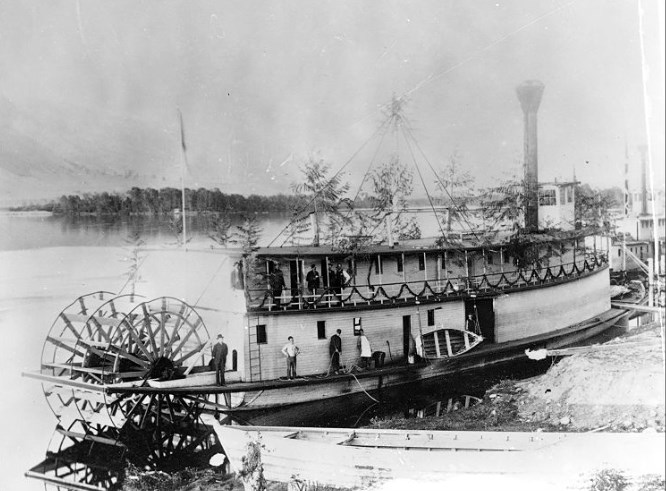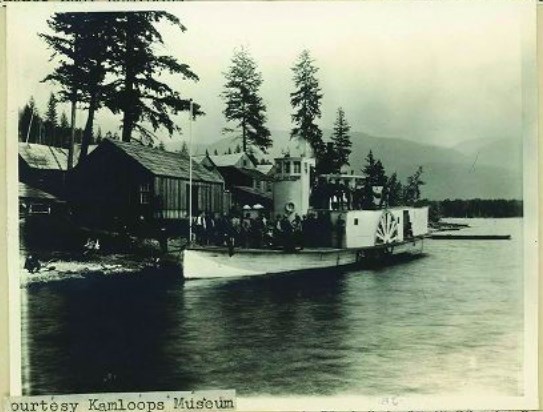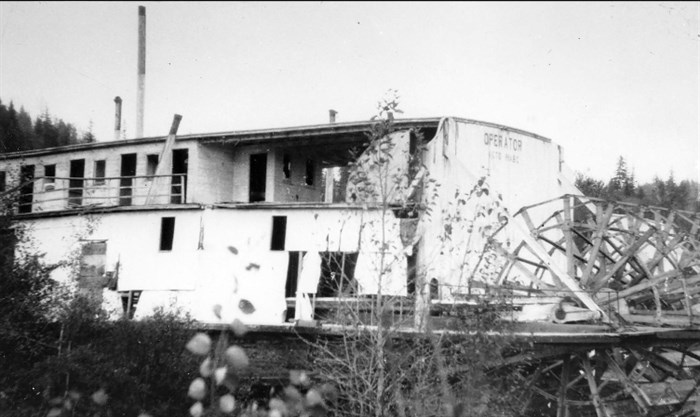
The SS Peerless was the biggest of the paddle wheelers that plied the waters of the Thompson and Shuswap regions.
Image Credit: Submitted/Museum and Archives of Vernon
July 09, 2023 - 6:00 AM
The Okanagan has many stories and displays of its paddle wheelers but other versions of those classic ships plied the rivers and lakes from Savona, through Kamloops, to Enderby.
“Back in the paddle wheel days, there were not many ways to import goods to the Okanagan,” says an Enderby Museum and Archives posting.
“Railroads were not built until 1892, which was still a long way off, and roads were not that great, especially with nothing economically feasible to transport the goods with. The cheapest and easiest way, by far, was on water via the Thompson-Shuswap river system.”
Enderby (originally called Fortune’s Landing), was as far south as steamships could travel, although a canal through to the Okanagan had been contemplated.
READ MORE: If these pioneers had gotten their way, you could paddle from the Shuswap to Osoyoos
“All goods destined for the Okanagan had to be taken as far as Enderby by paddle wheeler, then off-loaded and taken over land as far as Okanagan Lake,” the museum posting says. “This fact alone is responsible for the location of Enderby today.”
According to Salmon Arm historian Jim Cooperman, in a Shuswap Passion posting, there were 19 paddlewheelers in all.
Some were sternwheelers, like those on Okanagan Lake, while others were side-wheelers.
They ranged in size from the 33-foot, 15-ton Red Star 1 all the way up to the 133-foot, 307-ton Peerless.
While some, like the SS Lady Dufferin, travelled all the way from Savona to Fortune’s Landing, many just went from Sicamous to Fortune’s Landing on what was originally known as the Spallumcheen (now Shuswap) River.
“Kamloops (#1) was the first boat known to have come up the Spallumcheen, and was built in 1872,” the museum website says. “The boat itself had 4.0 horsepower, had a registered tonnage of 11.79 and gross tonnage of 21.08. Captain Meneteau used her to carry freight, supplies; she was also used by the surveying crew for the C.P.R.
“But the Kamloops's most famous ‘cargo’ was the first white woman settler up the Shuswap River to the North Okanagan; on Sept. 19, 1874, she carried Mrs. A.L. Fortune to Fortune's Landing.”
That boat last ran in 1878.
It was actually predated by the SS Marten that was built with “whipsawn” lumber on the banks of Little Shuswap Lake. It was 125 feet long with a 40-horsepower steam engine, according to Cooperman.
Spallumcheen was built in Kamloops in 1878 but became known as "Noisy Peggy" to those who couldn't pronounce her name properly.
The Lady Dufferin was a sidewheeler built in Kamloops that same year.

The SS Lady Dufferin
Image Credit: Submitted/Enderby and District Museum and Archives
Lord Dufferin was the first Governor General of Canada to visit BC. That included a trip to Kamloops where he and Lady Dufferin were carried on the ship bearing her name.
While one source says it was built by W. Fortune, another says it was built in Kamloops by W. Fortuno at Tranquille.
The Peerless launched in Kamloops in 1881. It only drew 18 inches of water, had 16 watertight compartments and could travel at a speed of 18 knots.
READ MORE: iN PHOTOS: Treasure trove of historical depictions of life from Kamloops to Osoyoos
Its maiden run was down the Thompson River to Ashcroft with an easy return upriver.
“Feeling good about the first downriver run to Ashcroft, her skilled Captain (Irving) made a second run, this time all the way down to Spences Bridge,” says an excerpt from Bernie Fandrich’s book ‘BC Majestic Thompson River’ cited in Vancouver Observer in 2013.
The plan was to make regular runs to Spences Bridge to bring supplies to railroad construction crews.
But, loaded with fuel and supplies for the return trip, the Peerless ran into trouble in Black Canyon, below Ashcroft.
“It was June and the river in full run-off mode,” Fandrich wrote. “The Peerless groaned and hissed against the fast currents. The huge boils, whirlpools, powerful eddies and back-eddies common during spring runoff nearly smashed her against the steep canyon walls and rocks, over and over again. She gained a few meters, only to lose them in the next big surge of water.
“For days, she fought her way through the canyon’s rapids and hydraulics. Captain Irving, her skipper, was the only reason that she was not smashed against the rocks and canyon walls and destroyed in Black Canyon. Finally, five days later, the Peerless glided back into dock at Savona, her mind made up. She belonged on Kamloops Lake, not on the Thompson River.”
There were other problems for ships down on the Spallumcheen River.
“The Red Stars were by far the most important vessels to Enderby history,” the Enderby Museum article says. “They were primarily built to carry flour out to Sicamous where it could be loaded onto the train and shipped elsewhere.”
The Red Star 1 had a 1.5 horsepower engine, was 33 feet long and nine feet wide.

On of the two Red Star paddle wheelers.
Image Credit: Submitted/Enderby and District Museum and Archives
“They soon found out that the Red Star #1 drew too much water because it kept running aground in low water, so they took the machinery off her and put it on another hull which then became known as the Red Star #2,” the museum’s article says.
The original hull was sold, had 20 feet added onto it and renamed the Okanagan. It was later sold and moved to Okanagan Lake.
It should not be confused with the SS Okanagan paddle wheeler that was built by the CPR in Okanagan Landing in 1906.
That ship was 200 feet long and had accommodations for up to 400 people.
The Red Star 2, however, would also get hung up from time to time on the sand bars in the Spallumcheen River, giving it the nickname of "Slow Molasses.”
“This made time scheduling difficult because sometimes the boat would be stuck for hours, and other times it was clear sailing,” the Enderby Museum article says. “The Red Star was finally abandoned when a connecting railroad line came through to Okanagan Landing from Sicamous, eliminating the need for a vessel.”
Some of the Thompson/North Okanagan paddle wheelers were built specifically to service the lumber industry.
“From 1880 until 1906, sawmills in Kamloops and Kault (near Tappen) had virtual control of the Shuswap Lake bench lands through the timber berths that they held,” Cooperman wrote. “These companies built most of the steamships to transport the loggers, horse teams and equipment to the logging sites and to tow the booms of logs to the mills.”
The paddle wheelers were built with shallow drafts to not only avoid running aground on sandbars but to also be able to pull up on shore.
“Sorrento pioneer Ted Coubeaux once recalled how these boats were handier than the trains,” Cooperman wrote. “’If we had goods to ship we would simply wave a flag and Captain Ward would pull up to shore to load them up. He would even take boxes of apples and sacks of potatoes and trade them for flour and sugar.”
But the days of the paddle wheelers were numbered.
“By 1913, despite the excellent service and government help, the steamships became uneconomical and, in 1915, when many men left to fight in World War I, the service was discontinued.,” Cooperman wrote.
“The Andover was brought back into service in 1919. That included summer social outings with live bands but, by 1930, the combination of better roads and the economic depression brought the steamship service nearly to an end.
“In 1932, Billy Louie purchased the C.R. Lamb and ran it for six years. He had to petition the government to install a lift span on the Pritchard Bridge so he could provide service between Kamloops and Shuswap Lake. A dance floor was added to attract passengers for his moonlight cruises. But,in 1938, the dilapidated ship was beached in Kamloops and the sternwheeler era was over.”
READ MORE: Kamloops residents solve mystery, history of iconic Pritchard Bridge
While the Okanagan paddle wheel history lives on in the SS Sicamous Marine Heritage Park in Penticton, there’s no such remnant in the north, although the Enderby Museum does have a model paddle wheeler.
In Kamloops, there is the Kamloops Paddlewheelers Lions Club. At one time, there was also the Wanda Sue.
That was built by George Slack over a seven-year period and launched in 1983 as a 63-foot replica of the Kamloops. It plied the waters of the North and South Thompson rivers for almost 20 years as a tour boat, ending operations in 2004.
According to a 2007 Kamloops This Week article, the family was looking to sell the boat but they still owned it in 2017 when it broke loose from its moorings (or took it’s dock with it), floated downstream and damaged two docks.
The Nauticapedia says it was still floating in 2019.
To contact a reporter for this story, email Rob Munro or call 250-808-0143 or email the editor. You can also submit photos, videos or news tips to the newsroom and be entered to win a monthly prize draw.
We welcome your comments and opinions on our stories but play nice. We won't censor or delete comments unless they contain off-topic statements or links, unnecessary vulgarity, false facts, spam or obviously fake profiles. If you have any concerns about what you see in comments, email the editor in the link above. SUBSCRIBE to our awesome newsletter here.
News from © iNFOnews, 2023